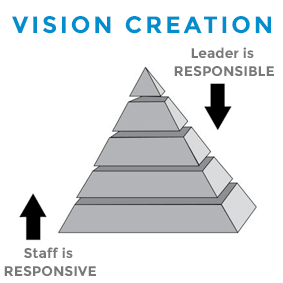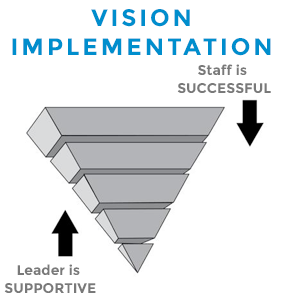These Soft Skills Will Make You a Top Leader
These Soft Skills Will Make You a Top Leader The internal, private needs of a leader today, are not about the rational, analytical and strategic...

There's no question that vision is a critical, driving force in your organization. Vision is the rallying cry that excites passion in your team and gives everyone a common goal to strive for.
I’m often asked to compare the differences between Christian workplaces and secular ones. As a man who has worked in both the marketplace and faith-based community, I can tell you from experience that, in many Christian organizations, it’s all about the vision. Leaders and their staff are often very passionate about the vision to which they feel called and certainly more so than many secular organizations.
The difference is that Christian organizations often stumble in implementing their vision. All too often, people join Christian organizations for the vision and leave because of the leadership.
How we respond to three, brief questions can help us avoid this common pitfall.
In my experience, Christian organizations can be very leader-centric, meaning people look to the leader for vision and direction. And while even Ken Blanchard believes the leader’s role is to lead the creation of the vision (a task that cannot be delegated to others), there is a delicate balance that must be struck between solitary vision and shared vision.
 The Lead Like Jesus curriculum uses a pyramid diagram to illustrate the leader's role in vision creation. The leader is at the top, casting vision for the rest of the organization. Many leaders follow the "Moses Model" of visionary leadership, arguing that it certainly worked for him! I suggest on the other hand, that it is a very rare leader who can pull off this approach, in which the solitary leader goes to the mountain to bring back the new vision on tablets made of stone.
The Lead Like Jesus curriculum uses a pyramid diagram to illustrate the leader's role in vision creation. The leader is at the top, casting vision for the rest of the organization. Many leaders follow the "Moses Model" of visionary leadership, arguing that it certainly worked for him! I suggest on the other hand, that it is a very rare leader who can pull off this approach, in which the solitary leader goes to the mountain to bring back the new vision on tablets made of stone.
Jerry White, President Emeritus of The Navigators, is living proof of this. In talking about his accomplishments during his remarkable tenure, Jerry tried to develop a new vision three times in his eighteen years as president. "What worked the third time," he said, "was involving others more in the development process. As a result, the vision finally stuck."
As I interview staff in Christian workplaces, over and over again they express a desire for greater clarity and a shared vision – a clearer, more compelling sense of “where we are going.” Lesson: The more people are included in giving input into the vision, the more successful the design and ultimately the buy-in for implementation.
This is where traditional top-down, hierarchical leaders get in trouble. These leaders can’t let go of control, and thus, the energy in the organization goes toward the leader and away from those the organization is trying to serve. The result is often a frustrated and underutilized staff.
 If your people are describing the organization structure as top down, hierarchical, autocratic or authoritative, you are underachieving your potential as an organization.
If your people are describing the organization structure as top down, hierarchical, autocratic or authoritative, you are underachieving your potential as an organization.
Blanchard points out the pyramid must be turned upside down for successful implementation of the vision. Why? Because the people who have the most direct contact with those they serve (the "customer," so to speak) must be on top, and the leader must be on the bottom supporting them. The implementation role of the leader is to live according to the vision and values and to support the staff in making it happen. Micro-managing the implementation leads to failure.
[shareable cite="Al Lopus"]Micro-managing the implementation of your vision leads to failure.[/shareable]
Our BCWI research indicates management competency is the most highly correlated element of staff engagement in Christian organizations, and yet, it is often an organization's greatest weakness. As a result, staff feel frustrated.
Why? Because staff feel called by God to serve in ministry, yet poor process often hinders their own ability to serve. These structural dysfunctions often lead to broken relationships and a lack of trust with leadership and with each other. As a result, the level of cynicism that creeps into Christian organizations is not only discouraging but crippling. Gradually, the culture can become toxic and the effort required to change becomes significant.
So how can leaders prevent this from happening? The visionary leader must transition into a supportive implementation role. Picture Jesus washing the feet of His disciples. Following His example will allow us to:
As a top leader, your role is key in developing and living the organizational vision – together, with your people. As you create the vision in collaboration with your people and coach them, day-to-day, to live according to that vision, a new kind of unity will emerge to honor and bring about God's purposes and plans.
[shareable cite="Al Lopus"]As a top leader, your key role is developing and living the organizational vision – together, with your people.[/shareable]

These Soft Skills Will Make You a Top Leader The internal, private needs of a leader today, are not about the rational, analytical and strategic...

5 Hidden Treasures to Enrich Your Workplace Culture Before you close the book on 2019, take delight in asking yourself this question: